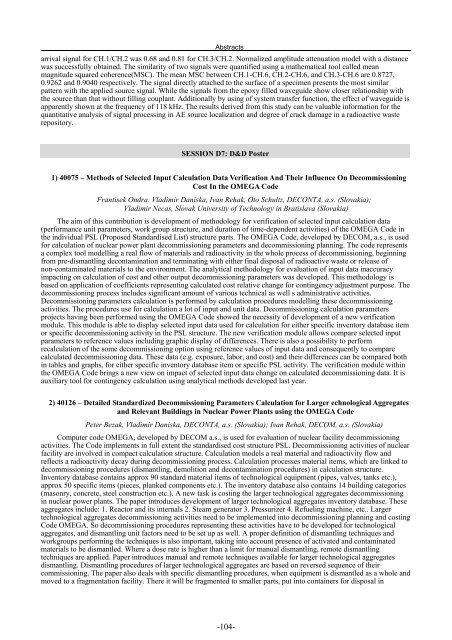ASME Message
ASME Message
ASME Message
You also want an ePaper? Increase the reach of your titles
YUMPU automatically turns print PDFs into web optimized ePapers that Google loves.
Abstracts<br />
arrival signal for CH.1/CH.2 was 0.68 and 0.81 for CH.3/CH.2. Normalized amplitude attenuation model with a distance<br />
was successfully obtained. The similarity of two signals were quantified using a mathematical tool called mean<br />
magnitude squared coherence(MSC). The mean MSC between CH.1-CH.6, CH.2-CH.6, and CH.3-CH.6 are 0.8727,<br />
0.9262 and 0.9040 respectively. The signal directly attached to the surface of a specimen presents the most similar<br />
pattern with the applied source signal. While the signals from the epoxy filled waveguide show closer relationship with<br />
the source than that without filling couplant. Additionally by using of system transfer function, the effect of waveguide is<br />
apparently shown at the frequency of 118 kHz. The results derived from this study can be valuable information for the<br />
quantitative analysis of signal processing in AE source localization and degree of crack damage in a radioactive waste<br />
repository.<br />
SESSION D7: D&D Poster<br />
1) 40075 – Methods of Selected Input Calculation Data Verification And Their Influence On Decommissioning<br />
Cost In the OMEGA Code<br />
Frantisek Ondra. Vladimir Daniska, Ivan Rehak, Oto Schultz, DECONTA, a.s. (Slovakia);<br />
Vladimir Necas, Slovak University of Technology in Bratislava (Slovakia)<br />
The aim of this contribution is development of methodology for verification of selected input calculation data<br />
(performance unit parameters, work group structure, and duration of time-dependent activities) of the OMEGA Code in<br />
the individual PSL (Proposed Standardised List) structure parts. The OMEGA Code, developed by DECOM, a.s., is used<br />
for calculation of nuclear power plant decommissioning parameters and decommissioning planning. The code represents<br />
a complex tool modelling a real flow of materials and radioactivity in the whole process of decommissioning, beginning<br />
from pre-dismantling decontamination and terminating with either final disposal of radioactive waste or release of<br />
non-contaminated materials to the environment. The analytical methodology for evaluation of input data inaccuracy<br />
impacting on calculation of cost and other output decommissioning parameters was developed. This methodology is<br />
based on application of coefficients representing calculated cost relative change for contingency adjustment purpose. The<br />
decommissioning process includes significant amount of various technical as well s administrative activities.<br />
Decommissioning parameters calculation is performed by calculation procedures modelling these decommissioning<br />
activities. The procedures use for calculation a lot of input and unit data. Decommissioning calculation parameters<br />
projects having been performed using the OMEGA Code showed the necessity of development of a new verification<br />
module. This module is able to display selected input data used for calculation for either specific inventory database item<br />
or specific decommissioning activity in the PSL structure. The new verification module allows compare selected input<br />
parameters to reference values including graphic display of differences. There is also a possibility to perform<br />
recalculation of the some decommissioning option using reference values of input data and consequently to compare<br />
calculated decommissioning data. These data (e.g. exposure, labor, and cost) and their differences can be compared both<br />
in tables and graphs, for either specific inventory database item or specific PSL activity. The verification module within<br />
the OMEGA Code brings a new view on impact of selected input data change on calculated decommissioning data. It is<br />
auxiliary tool for contingency calculation using analytical methods developed last year.<br />
2) 40126 – Detailed Standardized Decommissioning Parameters Calculation for Larger echnological Aggregates<br />
and Relevant Buildings in Nuclear Power Plants using the OMEGA Code<br />
Peter Bezak, Vladimir Daniska, DECONTA, a.s. (Slovakia); Ivan Rehak, DECOM, a.s. (Slovakia)<br />
Computer code OMEGA, developed by DECOM a.s., is used for evaluation of nuclear facility decommissioning<br />
activities. The Code implements in full extent the standardised cost structure PSL. Decommissioning activities of nuclear<br />
facility are involved in compact calculation structure. Calculation models a real material and radioactivity flow and<br />
reflects a radioactivity decay during decommissioning process. Calculation processes material items, which are linked to<br />
decommissioning procedures (dismantling, demolition and decontamination procedures) in calculation structure.<br />
Inventory database contains approx 90 standard material items of technological equipment (pipes, valves, tanks etc.),<br />
approx 50 specific items (pieces, planked components etc.). The inventory database also contains 14 building categories<br />
(masonry, concrete, steel construction etc.). A new task is costing the larger technological aggregates decommissioning<br />
in nuclear power plants. The paper introduces development of larger technological aggregates inventory database. These<br />
aggregates include: 1. Reactor and its internals 2. Steam generator 3. Pressurizer 4. Refueling machine, etc.. Larger<br />
technological aggregates decommissioning activities need to be implemented into decommissioning planning and costing<br />
Code OMEGA. So decommissioning procedures representing these activities have to be developed for technological<br />
aggregates, and dismantling unit factors need to be set up as well. A proper definition of dismantling techniques and<br />
workgroups performing the techniques is also important, taking into account presence of activated and contaminated<br />
materials to be dismantled. Where a dose rate is higher than a limit for manual dismantling, remote dismantling<br />
techniques are applied. Paper introduces manual and remote techniques available for larger technological aggregates<br />
dismantling. Dismantling procedures of larger technological aggregates are based on reversed sequence of their<br />
commissioning. The paper also deals with specific dismantling procedures, when equipment is dismantled as a whole and<br />
moved to a fragmentation facility. There it will be fragmented to smaller parts, put into containers for disposal in<br />
-104-


